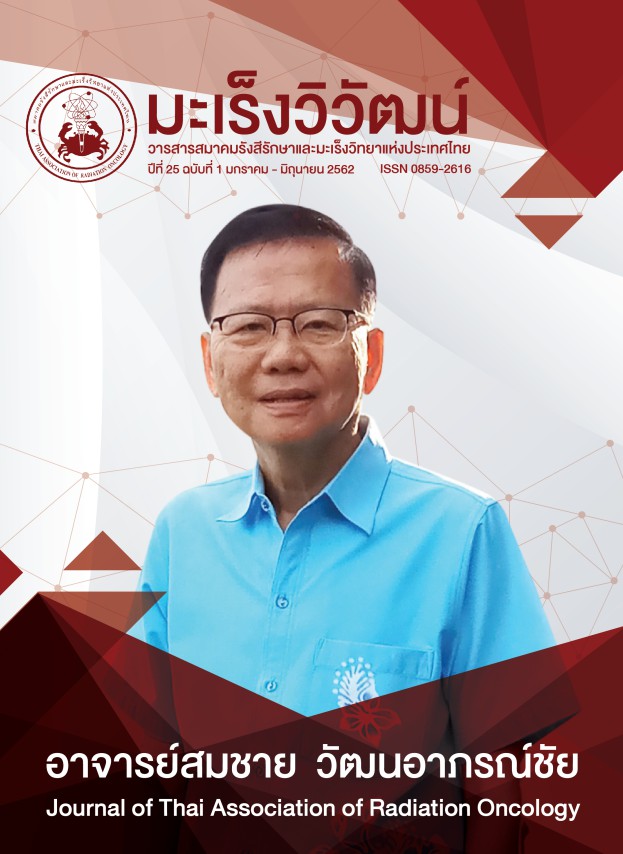FF and FFF patient specific QA using new Varian aS1200 portal imager and compare with PTW Octavius 1500
Keywords:
aS1200 EPID, Patient specific QA, PTW Octavius 1500Abstract
Background: An electronic portal imaging device (EPID) is an effective tool for patient specific quality assurance (QA) because of its performance and user-friendly. However, signal saturation can occur when using imager in high dose rate range, especially in flattening filter free (FFF) beams. Objective: To investigate a new Varian EPID (aS1200) with Portal Dosimetry implementation for patient specific QA in FF and FFF beams with a new gamma index criteria, which proposed by AAPM TG-218, and compared the result with PTW Octavius 1500 with PTW Octavius 4D system. Materials and methods: Randomly selected thirty patient’s VMAT plans were recalculated into sixty plans by the other beam mode using Eclipse TPS (V.13.6). Therefore, sixty plans were composed of thirty FF plans and thirty FFF plans in various tumor sites and applied for patient specific QA implementation by aS1200 EPID and PTW Octavius 1500. Gamma index criteria from AAPM TG-119 (global normalization with 3% DD/3 mm DTA and 10% low dose threshold) and AAPM TG-218 (global normalization with 3% DD/2 mm DTA and 10% low dose threshold) were applied for result interpretation. Results: In FF and FFF plans, the results showed most of the percent gamma passing rate of aS1200 EPID were slightly lower with higher SD than PTW Octavius 1500, except in stringent criteria for FFF plans. According to the AAPM TG-119, the mean gamma passing rate of aS1200 EPID and PTW Octavius 1500 was 99.02% ± 1.60% and 99.80% ± 0.52%, respectively. For AAPM TG-218, the results of aS1200 EPID and PTW Octavius 1500 was 98.36% ± 2.50% and 98.66% ± 1.86%, respectively. Conclusion: The results of the study revealed that both systems showed comparable results for a new gamma criteria. Both systems can be used as alternative detectors for patient specific QA.
References
Greer PB, Vial P, Oliver L, Baldock C. Experimental investigation of the response of an amorphous silicon EPID to intensity modulated radiotherapy beams. Med Phys 2007; 34:4389-98.
McDermott L, Nijsten S, Sonke JJ, Partridge M, Van Herk M, Mijnheer B. Comparison of ghosting effects for three commercial a-Si EPIDs. Med Phys 2006; 33:2448-51.
4. Rowshanfarzad P, McCurdy B, Sabet M, Lee C, O’Connor DJ, Greer PB. Measurement and modeling of the effect of support arm backscatter on dosimetry with a Varian EPID. Med Phys 2010;37: 2269-78.
Nicolini G, Clivio A, Vanetti E, Krauss H, Fenoglietto P, Cozzi L, et al. Evaluation of an aSi‐EPID with flattening filter free beams: Applicability to the GLAaS algorithm for portal dosimetry and first experience for pretreatment QA of RapidArc. Med Phys 2013; 40:111719.
Ezzell GA, Burmeister JW, Dogan N, LoSasso TJ, Mechalakos JG, Mihailidis D, et al. IMRT commissioning: multiple institution planning and dosimetry comparisons, a report from AAPM Task Group 119. Med Phys 2009; 36:5359-73.
7. Miften M, Olch A, Mihailidis D, Moran J, Pawlicki T, Molineu A, et al. Tolerance limits and methodologies for IMRT measurement-based verification QA: Recommendations of AAPM Task Group No. 218. Med Phys 2018; 45:e53-e83.
Van Esch A, Depuydt T, Huyskens DP. The use of an aSi-based EPID for routine absolute dosimetric pre-treatment verification of dynamic IMRT fields. Radiother Oncol 2004; 71:223-34.
Stelljes T, Harmeyer A, Reuter J, Looe H, Chofor N, Harder D, et al. Dosimetric characteristics of the novel 2D ionization chamber array OCTAVIUS Detector 1500. Med Phys 2015; 42:1528-37.
Low DA, Harms WB, Mutic S, Purdy JA. A technique for the quantitative evaluation of dose distributions. Med Phys 1998; 25:656-61.
Rajasekaran D, Jeevanandam P, Sukumar P, Ranganathan A, John jothi S, Nagarajan V. A study on correlation between 2D and 3D gamma evaluation metrics in patient-specific quality assurance for VMAT. Med Dosim 2014; 39:300-8.
Van Esch A, Huyskens DP, Hirschi L, Scheib S, Baltes C. Optimized Varian aSi portal dosimetry: development of datasets for collective use. J Appl Clin Med Phys 2013; 14:82-99.
Beyer G, Gago P, Ruiz G. PD-0380: FFF pre-treatment QA using TrueBeam Portal Dosimetry with DMI panel and comparison with PTW Octavius 1500. Radiother Oncol 2015; 115:S182.
Downloads
Published
How to Cite
Issue
Section
License
บทความที่ได้รับการตีพิมพ์เป็นลิขสิทธิ์ของวารสารมะเร็งวิวัฒน์ ข้อความที่ปรากฏในบทความแต่ละเรื่องในวารสารวิชาการเล่มนี้เป็นความคิดเห็นส่วนตัวของผู้เขียนแต่ละท่านไม่เกี่ยวข้องกับ และบุคคลากรท่านอื่น ๆ ใน สมาคมฯ แต่อย่างใด ความรับผิดชอบองค์ประกอบทั้งหมดของบทความแต่ละเรื่องเป็นของผู้เขียนแต่ละท่าน หากมีความผิดพลาดใดๆ ผู้เขียนแต่ละท่านจะรับผิดชอบบทความของตนเองแต่ผู้เดียว




